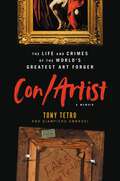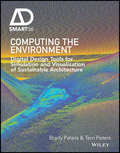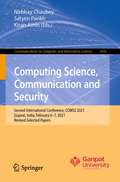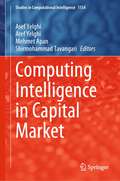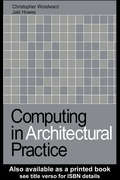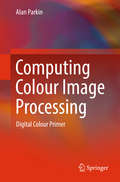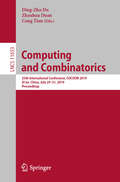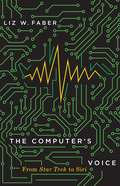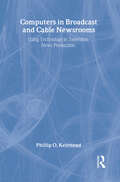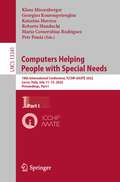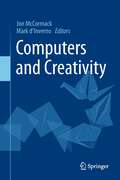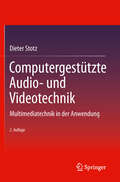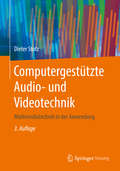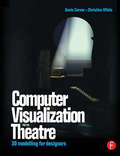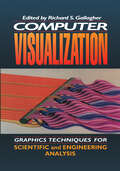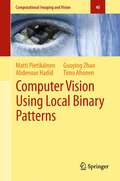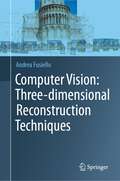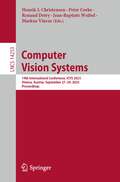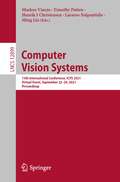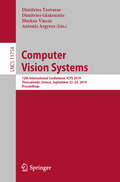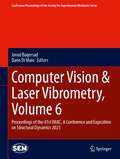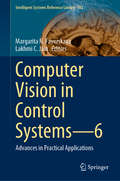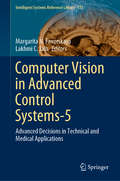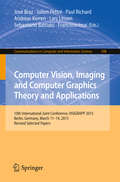- Table View
- List View
Con/Artist: The Life and Crimes of the World's Greatest Art Forger
by Tony Tetro Giampiero AmbrosiThe world&’s most renowned art forger reveals the secrets behind his decades of painting like the masters—exposing an art world that is far more corrupt than we ever knew while providing an art history lesson wrapped in sex, drugs, and Caravaggio. The art world is a much dirtier, nastier business than you might expect. Tony Tetro, one of the most renowned art forgers in history, will make you question every masterpiece you&’ve ever seen in a museum, gallery, or private collection. Tetro&’s &“Rembrandts,&” &“Caravaggios,&” &“Miros,&” and hundreds of other works now hang on walls around the globe. In 2019, it was revealed that Prince Charles received into his collection a Picasso, Dali, Monet, and Chagall, insuring them for over 200 million pounds, only to later discover that they&’re actually &“Tetros.&” And the kicker? In Tony&’s words: &“Even if some tycoon finds out his Rembrandt is a fake, what&’s he going to do, turn it in? Now his Rembrandt just became motel art. Better to keep quiet and pass it on to the next guy. It&’s the way things work for guys like me.&” The Prince Charles scandal is the subject of a forthcoming feature documentary with Academy Award nominee Kief Davidson and coauthor Giampiero Ambrosi, in cooperation with Tetro. Throughout Tetro&’s career, his inimitable talent has been coupled with a reckless penchant for drugs, fast cars, and sleeping with other con artists. He was busted in 1989 and spent four years in court and one in prison. His voice—rough, wry, deeply authentic—is nothing like the high society he swanned around in, driving his Lamborghini or Ferrari, hobnobbing with aristocrats by day, and diving into debauchery when the lights went out. He&’s a former furniture store clerk who can walk around in Caravaggio&’s shoes, become Picasso or Monet, with an encyclopedic understanding of their paint, their canvases, their vision. For years, he hid it all in an unassuming California townhouse with a secret art room behind a full-length mirror. (Press #* on his phone and the mirror pops open.) Pairing up with coauthor Ambrosi, one of the investigative journalists who uncovered the 2019 scandal, Tetro unveils the art world in an epic, alluring, at times unbelievable, but all-true narrative.
Computing the Environment: Digital Design Tools for Simulation and Visualisation of Sustainable Architecture (AD Smart)
by Brady Peters Terri PetersComputing the Environment presents practical workflows and guidance for designers to get feedback on their design using digital design tools on environmental performance. Starting with an extensive state-of-the-art survey of what top international offices are currently using in their design projects, this book presents detailed descriptions of the tools, algorithms, and workflows used and discusses the theories that underlie these methods. Project examples from Transsolar Klimaengineering, Buro Happold´s SMART Group, Behnish Behnisch Architects, Thomas Herzog, Autodesk Research are contextualized with quotes and references to key thinkers in this field such as Eric Winsberg, Andrew Marsh, Michelle Addington and Ali Malkawi.
Computing Science, Communication and Security: Second International Conference, COMS2 2021, Gujarat, India, February 6–7, 2021, Revised Selected Papers (Communications in Computer and Information Science #1416)
by Nirbhay Chaubey Satyen Parikh Kiran AminThis book constitutes revised selected papers of the Second International Conference on Computing Science, Communication and Security, COMS2 2021, held in Gandhinagar, India, in February 2021. Due to the COVID-19 pandemic the conference was held virtually. The 19 full papers were thoroughly reveiwed and selected from 105 submissions. Papers are organised according to the topical sections on artificial intelligence and machine learning; networking and communications.
Computing Intelligence in Capital Market (Studies in Computational Intelligence #1154)
by Asef Yelghi Aref Yelghi Mehmet Apan Shirmohammad TavangariThe book is divided into sections according to the content of the chapters. The first section covers AI concepts with NP and financial issues. The second section covers AI techniques in relation to Fintech issues. The remaining sections are implementation and analysis. As science and technology development and algorithms are widely used in various fields, their influence and development have increased efficiency and productivity. The introduction of algorithms in the financial field has not been an exception to this. In recent years, the growth and development of the financial system have been in sync with the growth of technology. Fintechs were born at the intersection of these two sectors. What happens through the application of computer knowledge in the financial field, or the examination of the efficiency and effectiveness of their use and the interaction and combination of these two fields has been written very infrequently in the majority of books. In Fintech, there are problems that researchers focus on such as customer support, portfolio management, trading algorithms, fraud detection, credit risk assessment, insurance, and wealth management. The mentioned problems are complex and are mapped to NP problems in the field of artificial intelligence. In the last two decades, optimization algorithms, neural networks, and deep learning have been widely applied in many scientific and engineering fields to solve the mentioned problems. The purpose of this book is to provide the reader with the most used artificial intelligence methods for scientific and engineering problems. This book is used by students, scientists, and practitioners in various fields. The chapters are self-explanatory, and the reader can read each one separately. They describe the algorithm used, the chosen problem, and the implementation. In addition, practical examples, comparisons, and experimental results are presented.
Computing in Architectural Practice
by Jaki Howes Christopher WoodwardThis book provides a concise introduction for small and medium sized architectural practices considering introducing computers or using them more widely.
Computing Colour Image Processing: Digital Colour Primer (SpringerBriefs in Applied Sciences and Technology)
by Alan ParkinThis book proposes a new approach to colour in digital images, based on the standard sRGB colour space and Python scripting. It covers creating, storing, processing, displaying, printing, and viewing colour images. The fundamental ideas presented include systematic reduction of colour resolution to manageable sRGB sub-spaces, analysis of any image as a tabular colour scheme, general transformation and specific substitution of colours, and revival of the traditional notion of a neutral balance by adjusting all colours or by adjoining a colour frame. The text includes Python scripts for the processes discussed, downloadable in the e-book. It is of interest to artists, designers, and anyone who works with sRGB colour images.
Computing and Combinatorics: 25th International Conference, COCOON 2019, Xi'an, China, July 29–31, 2019, Proceedings (Lecture Notes in Computer Science #11653)
by Ding-Zhu Du Zhenhua Duan Cong TianThis book constitutes the proceedings of the 25th International Conference on Computing and Combinatorics, COCOON 2019, held in Xi’an, China, in July 2019. The 55 papers presented in this volume were carefully reviewed and selected from 124 submissions. The papers cover various topics, including algorithm design, approximation algorithm, graph theory, complexity theory, problem solving, optimization, computational biology, computational learning, communication network, logic, and game theory.
The Computer's Voice: From Star Trek to Siri
by Liz W. FaberA deconstruction of gender through the voices of Siri, HAL 9000, and other computers that talk Although computer-based personal assistants like Siri are increasingly ubiquitous, few users stop to ask what it means that some assistants are gendered female, others male. Why is Star Trek&’s computer coded as female, while HAL 9000 in 2001: A Space Odyssey is heard as male? By examining how gender is built into these devices, author Liz W. Faber explores contentious questions around gender: its fundamental constructedness, the rigidity of the gender binary, and culturally situated attitudes on male and female embodiment.Faber begins by considering talking spaceships like those in Star Trek, the film Dark Star, and the TV series Quark, revealing the ideologies that underlie space-age progress. She then moves on to an intrepid decade-by-decade investigation of computer voices, tracing the evolution from the masculine voices of the &’70s and &’80s to the feminine ones of the &’90s and &’00s. Faber ends her account in the present, with incisive looks at the film Her and Siri herself.Going beyond current scholarship on robots and AI to focus on voice-interactive computers, The Computer&’s Voice breaks new ground in questions surrounding media, technology, and gender. It makes important contributions to conversations around the gender gap and the increasing acceptance of transgender people.
Computers Of Star Trek
by Lois H. Gresh Robert WeinbergThe depiction of computers on the various "Star Trek" series has ranged from lame to breathtakingly imaginative. This book covers the gamut, and makes lucid and entertaining comparison of these fictional computers with those that now exist or are likely to inhabit our future. Throughout its history, "Star Trek" has been an accurate reflection of contemporary ideas about computers and their role in our lives. Affectionately but without illusions, The Computers of Star Trek shows how those ideas compare with what we now know we can and will do with computers.
Computers in Broadcast and Cable Newsrooms: Using Technology in Television News Production (Routledge Communication Series)
by Phillip O. KeirsteadComputers in Broadcast and Cable Newsrooms: Using Technology in Television News Production takes readers through the use of computers and software in the broadcast/cable newsroom environment. Author Phillip O. Keirstead began writing about television news technology decades ago in an effort to help television news managers cope with technological change. In this text, he demonstrates the myriad ways in which today's journalism is tied to technology, and he shows how television news journalists rely on varied and complex technologies to produce timely, interesting, and informative broadcasts. Using a hands-on, practical approach to cover the role computers play in various parts of the newsroom, the volume will be of great practical value to undergraduate and graduate students in advanced broadcast/news television courses.
Computers Helping People with Special Needs: 18th International Conference, ICCHP-AAATE 2022, Lecco, Italy, July 11–15, 2022, Proceedings, Part I (Lecture Notes in Computer Science #13341)
by Klaus Miesenberger Georgios Kouroupetroglou Katerina Mavrou Roberto Manduchi Mario Covarrubias Rodriguez Petr PenázThe two-volume set LNCS 13341 and 13342 constitutes the refereed proceedings of the Joint International Conference on Digital Inclusion, Assistive Technology, and Accessibility, ICCHP-AAATE 2022. The conference was held in Lecco, Italy, in July 2022.The 112 papers presented were carefully reviewed and selected from 285 submissions. Included also are 18 introductions. The papers are organized in the following topical sections: Part I: Art Karshmer Lectures in Access to Mathematics, Science and Engineering; Digital Solutions for Inclusive Mobility: solutions and accessible maps for indoor and outdoor mobility; implementation and innovation in the area of independent mobility through digital technologies; haptic and digital access to art and artefacts; accessibility of co-located meetings; interactions for text input and alternative pointing; cognitive disabilities and accessibility; augmentative and alternative communication (AAC): emerging trends, opportunities and innovations; language accessibility for the deaf and hard-of-hearing. Part II: Digital accessibility: readability and understandability; serious and fun games; internet of things: services and applications for people with disabilities and elderly persons; technologies for inclusion and participation at work and everyday activities; robotic and virtual reality technologies for children with disabilities and older adults; development, evaluation and assessment of assistive technologies; ICT to support inclusive education – universal learning design (ULD); design for assistive technologies and rehabilitation; assistive technologies and inclusion for older people.
Computers and Creativity
by Jon Mccormack Mark D’invernoThis interdisciplinary volume introduces new theories and ideas on creativity from the perspectives of science and art. Featuring contributions from leading researchers, theorists and artists working in artificial intelligence, generative art, creative computing, music composition, and cybernetics, the book examines the relationship between computation and creativity from both analytic and practical perspectives. Each contributor describes innovative new ways creativity can be understood through, and inspired by, computers. The book tackles critical philosophical questions and discusses the major issues raised by computational creativity, including: whether a computer can exhibit creativity independently of its creator; what kinds of creativity are possible in light of our knowledge from computational simulation, artificial intelligence, evolutionary theory and information theory; and whether we can begin to automate the evaluation of aesthetics and creativity in silico. These important, often controversial questions are contextualised by current thinking in computational creative arts practice. Leading artistic practitioners discuss their approaches to working creatively with computational systems in a diverse array of media, including music, sound art, visual art, and interactivity. The volume also includes a comprehensive review of computational aesthetic evaluation and judgement research, alongside discussion and insights from pioneering artists working with computation as a creative medium over the last fifty years. A distinguishing feature of this volume is that it explains and grounds new theoretical ideas on creativity through practical applications and creative practice. Computers and Creativity will appeal to theorists, researchers in artificial intelligence, generative and evolutionary computing, practicing artists and musicians, students and any reader generally interested in understanding how computers can impact upon creativity. It bridges concepts from computer science, psychology, neuroscience, visual art, music and philosophy in an accessible way, illustrating how computers are fundamentally changing what we can imagine and create, and how we might shape the creativity of the future. Computers and Creativity will appeal to theorists, researchers in artificial intelligence, generative and evolutionary computing, practicing artists and musicians, students and any reader generally interested in understanding how computers can impact upon creativity. It bridges concepts from computer science, psychology, neuroscience, visual art, music and philosophy in an accessible way, illustrating how computers are fundamentally changing what we can imagine and create, and how we might shape the creativity of the future.
Computergestützte Audio- und Videotechnik: Multimediatechnik in der Anwendung
by Dieter StotzDiese Einführung in die moderne Audio- und Videotechnik ermöglicht Lesern mit technischem Grundverständnis einen leichten Einstieg - auch in komplexe Zusammenhänge. Der Autor vermittelt detailliertes Wissen, praxisnah und verständlich aufbereitet: von den Grundlagen der Ton- und Videotechnik über Abtastung und Digitalisierung, räumliches Hören, Datenkompression, MIDI-Standard und -Signale, digitale Audiomesstechnik bis zu hochauflösender Videotechnik, Genlock, Chromakeying, Schnittsystemen und Animation. Mit vielen Graphiken und Abbildungen.
Computergestützte Audio- und Videotechnik: Multimediatechnik in der Anwendung
by Dieter StotzDiese Einführung in die moderne Audio- und Videotechnik ermöglicht Lesern mit technischem Grundverständnis einen leichten Einstieg – auch in komplexe Zusammenhänge. Der Autor vermittelt detailliertes Wissen, praxisnah und verständlich aufbereitet: von den Grundlagen der Ton- und Videotechnik über Abtastung und Digitalisierung, räumliches Hören, Datenkompression, MIDI-Standard und -Signale, digitale Audiomesstechnik bis zu hochauflösender Videotechnik, Genlock, Chromakeying, Schnittsystemen und Animation. Mit vielen Graphiken und Abbildungen.
Computer Visualization for the Theatre: 3D Modelling for Designers
by Gavin Carver Christine WhiteTheatre designers using 3D software for computer visualisation in the theatre will find this book both a guide to the creative design process as well as an introduction to the use of computers in live performance. Covering the main software packages in use: Strata Studio Base, 3D Studio Max and 3D Studio Viz, the book provides techniques for 3D modelling alongside creative ideas and concepts for working in 3D space. Projects are provided to sharpen your awareness and digital skills as well as suggested further reading to broaden the scope of your theatrical and design knowledge. This book is both a useful day to day reference as well as an inspirational starting point for implementing your own ideas. The authors are experienced trainers in the field and understand the pitfalls to be avoided as well as the possibilities to be explored using computer visualisation for designing theatre space. They provide insightful hands on descriptions of techniques used in the development of performance projects set in the wider context of design considerations. The book is highly informative about the technology of computer visualisation providing examples of working practice applicable to all software.
Computer Visualization: Graphics Techniques for Engineering and Scientific Analysis
by Richard S. GallagherRapid advances in 3-D scientific visualization have made a major impact on the display of behavior. The use of 3-D has become a key component of both academic research and commercial product development in the field of engineering design. Computer Visualization presents a unified collection of computer graphics techniques for the scientific visualization of behavior. The book combines a basic overview of the fundamentals of computer graphics with a practitioner-oriented review of the latest 3-D graphics display and visualization techniques. Each chapter is written by well-known experts in the field. The first section reviews how computer graphics visualization techniques have evolved to work with digital numerical analysis methods. The fundamentals of computer graphics that apply to the visualization of analysis data are also introduced. The second section presents a detailed discussion of the algorithms and techniques used to visualize behavior in 3-D, as static, interactive, or animated imagery. It discusses the mathematics of engineering data for visualization, as well as providing the current methods used for the display of scalar, vector, and tensor fields. It also examines the more general issues of visualizing a continuum volume field and animating the dimensions of time and motion in a state of behavior. The final section focuses on production visualization capabilities, including the practical computational aspects of visualization such as user interfaces, database architecture, and interaction with a model. The book concludes with an outline of successful practical applications of visualization, and future trends in scientific visualization.
Computer Vision Using Local Binary Patterns: Computer Vision Using Local Binary Patterns (Computational Imaging and Vision #40)
by Guoying Zhao Matti Pietikäinen Timo Ahonen Abdenour HadidThe recent emergence of Local Binary Patterns (LBP) has led to significant progress in applying texture methods to various computer vision problems and applications. The focus of this research has broadened from 2D textures to 3D textures and spatiotemporal (dynamic) textures. Also, where texture was once utilized for applications such as remote sensing, industrial inspection and biomedical image analysis, the introduction of LBP-based approaches have provided outstanding results in problems relating to face and activity analysis, with future scope for face and facial expression recognition, biometrics, visual surveillance and video analysis. Computer Vision Using Local Binary Patterns provides a detailed description of the LBP methods and their variants both in spatial and spatiotemporal domains. This comprehensive reference also provides an excellent overview as to how texture methods can be utilized for solving different kinds of computer vision and image analysis problems. Source codes of the basic LBP algorithms, demonstrations, some databases and a comprehensive LBP bibliography can be found from an accompanying web site. Topics include: local binary patterns and their variants in spatial and spatiotemporal domains, texture classification and segmentation, description of interest regions, applications in image retrieval and 3D recognition - Recognition and segmentation of dynamic textures, background subtraction, recognition of actions, face analysis using still images and image sequences, visual speech recognition and LBP in various applications. Written by pioneers of LBP, this book is an essential resource for researchers, professional engineers and graduate students in computer vision, image analysis and pattern recognition. The book will also be of interest to all those who work with specific applications of machine vision.
Computer Vision: Three-dimensional Reconstruction Techniques
by Andrea FusielloFrom facial recognition to self-driving cars, the applications of computer vision are vast and ever-expanding. Geometry plays a fundamental role in this discipline, providing the necessary mathematical framework to understand the underlying principles of how we perceive and interpret visual information in the world around us. This text explores the theories and computational techniques used to determine the geometric properties of solid objects through images. It covers the basic concepts and provides the necessary mathematical background for more advanced studies. The book is divided into clear and concise chapters covering a wide range of topics including image formation, camera models, feature detection and 3D reconstruction. Each chapter includes detailed explanations of the theory as well as practical examples to help the reader understand and apply the concepts presented. The book has been written with the intention of being used as a primary resource for students on university courses in computer vision, particularly final year undergraduate or postgraduate computer science or engineering courses. It is also useful for self-study and for those who, outside the academic field, find themselves applying computer vision to solve practical problems. The aim of the book is to strike a balance between the complexity of the theory and its practical applicability in terms of implementation. Rather than providing a comprehensive overview of the current state of the art, it offers a selection of specific methods with enough detail to enable the reader to implement them.
Computer Vision Systems: 14th International Conference, ICVS 2023, Vienna, Austria, September 27–29, 2023, Proceedings (Lecture Notes in Computer Science #14253)
by Henrik I. Christensen Peter Corke Renaud Detry Jean-Baptiste Weibel Markus VinczeThis volume LNCS 14253 constitutes the refereed proceedings of the 14th International Conference, ICVS 2023, in Vienna, Austria, in September 2023.. The 37 full papers presented were carefully reviewed and selected from 74 submissions. The conference focuses on Humans and Hands; Medical and Health Care; Farming and Forestry; Automation and Manufacturing; Mobile Robotics and Autonomous Systems; and Performance and Robustness.
Computer Vision Systems: 13th International Conference, ICVS 2021, Virtual Event, September 22-24, 2021, Proceedings (Lecture Notes in Computer Science #12899)
by Markus Vincze Timothy Patten Henrik I Christensen Lazaros Nalpantidis Ming LiuThis book constitutes the refereed proceedings of the 13th International Conference on Computer Vision Systems, ICVS 2021, held in September 2021. Due to COVID-19 pandemic the conference was held virtually. The 20 papers presented were carefully reviewed and selected from 29 submissions. cover a broad spectrum of issues falling under the wider scope of computer vision in real-world applications, including among others, vision systems for robotics, autonomous vehicles, agriculture and medicine. In this volume, the papers are organized into the sections: attention systems; classification and detection; semantic interpretation; video and motion analysis; computer vision systems in agriculture.
Computer Vision Systems: 12th International Conference, ICVS 2019, Thessaloniki, Greece, September 23–25, 2019, Proceedings (Lecture Notes in Computer Science #11754)
by Markus Vincze Dimitrios Tzovaras Dimitrios Giakoumis Antonis ArgyrosThis book constitutes the refereed proceedings of the 12th International Conference on Computer Vision Systems, ICVS 2019, held in Thessaloniki, Greece, in September 2019.The 72 papers presented were carefully reviewed and selected from 114 submissions. The papers are organized in the following topical sections; hardware accelerated and real time vision systems; robotic vision; vision systems applications; high-level and learning vision systems; cognitive vision systems; movement analytics and gesture recognition for human-machine collaboration in industry; cognitive and computer vision assisted systems for energy awareness and behavior analysis; and vision-enabled UAV and counter UAV technologies for surveillance and security of critical infrastructures.
Computer Vision & Laser Vibrometry, Volume 6: Proceedings of the 41st IMAC, A Conference and Exposition on Structural Dynamics 2023 (Conference Proceedings of the Society for Experimental Mechanics Series)
by Javad Baqersad Dario Di MaioComputer Vision & Laser Vibrometry, Volume 6: Proceedings of the 41st IMAC, A Conference and Exposition on Structural Dynamics, 2023, the sixth volume of ten from the Conference brings together contributions to this important area of research and engineering. The collection presents early findings and case studies on fundamental and applied aspects of Computer Vision, Laser Vibrometry and Structural Health Monitoring, including papers on:Novel TechniquesOptical Methods,Scanning LDV MethodsPhotogrammetry & DICStructural Health Monitoring
Computer Vision in Control Systems—6: Advances in Practical Applications (Intelligent Systems Reference Library #182)
by Lakhmi C. Jain Margarita N. FavorskayaThis book attempts to improve algorithms by novel theories and complex data analysis in different scopes including object detection, remote sensing, data transmission, data fusion, gesture recognition, and edical image processing and analysis.The book is directed to the Ph.D. students, professors, researchers, and software developers working in the areas of digital video processing and computer vision technologies.
Computer Vision in Advanced Control Systems-5: Advanced Decisions in Technical and Medical Applications (Intelligent Systems Reference Library #175)
by Margarita N. Favorskaya Lakhmi C. JainThis book applies novel theories to improve algorithms in complex data analysis in various fields, including object detection, remote sensing, data transmission, data fusion, gesture recognition, and medical image processing and analysis. It is intended for Ph.D. students, academics, researchers, and software developers working in the areas of digital video processing and computer vision technologies.
Computer Vision, Imaging and Computer Graphics Theory and Applications: 10th International Joint Conference, VISIGRAPP 2015, Berlin, Germany, March 11-14, 2015, Revised Selected Papers (Communications in Computer and Information Science #598)
by Sebastiano Battiato Julien Pettré Andreas Kerren José Braz Lars Linsen Paul Richard Francisco ImaiThis bookconstitutes thoroughly revised and selected papers from the 10thInternational Joint Conference on Computer Vision, Imaging and ComputerGraphics Theory and Applications, VISIGRAPP 2015, held in Berlin, Germany, inMarch 2015. VISIGRAPP comprises GRAPP, International Conference on ComputerGraphics Theory and Applications; IVAPP, International Conference onInformation Visualization Theory and Applications; and VISAPP, InternationalConference on Computer Vision Theory and Applications. The 23 thoroughly revised and extended papers presented in this volume werecarefully reviewed and selected from 529 submissions. The book also containsone invited talk in full-paper length. The regular papers were organized intopical sections named: computer graphics theory and applications; informationvisualization theory and applications; and computer vision theory andapplications.
